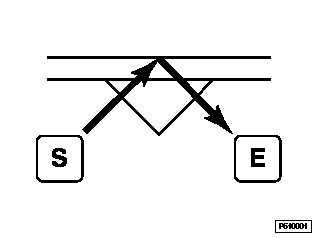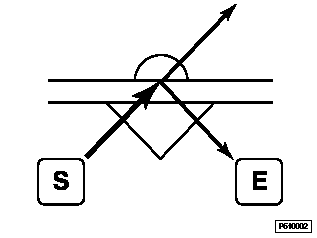
With the aid of a rain sensor, the automatic interval control (AIC) system senses water or dirt on the windscreen and activates the windscreen wipers accordingly.
The AIC consists of an optical element bonded on the windscreen, to which an electronic evaluator is connected.
The system is active as of ignition lock position 1. The wiper/washer switch must be set to the first stage (intermittent wipe setting).
The wiper motor is activated by the general module of ZKE. The electronic evaluator sends the instruction to activate the wiper motor via the K-bus to the general module.
The optical element is adhered to the windscreen behind the rear-view mirror. It consists of a glass body (prism) which routes the beams emitted by infrared diodes at a defined angle to the windscreen. The light beams reflected by the windscreen are routed by the optical element to the infrared receivers.
The optical element is heated by a heating element to ensure condensation cannot form on it.
The optical element is bonded together with the windscreen in a special process such as to guarantee the physical properties of the system. This bonding process cannot be carried out in the workshop. Therefore when replacing the windscreen, a special windscreen with the optical element already bonded to it must be used.
The electronic evaluator is connected to the optical element by means of a catch mechanism.
It contains the electronic components as well as the infrared diodes and infrared receivers.
The instruction to activate the wiper motor is given via the K-bus interface.
Water on the windscreen is detected on the basis of the reflection of infrared beams.

When the windscreen is dry, all infrared beams which are emitted by the infrared diodes "S" and which hit the windscreen at a defined angle are reflected in full by the windscreen and therefore reach the infrared receivers "E" also in full.

A proportion of these beams is deflected by a drop of water on the windscreen (in the area of the infrared diodes). These beams no longer reach the infrared receivers "E".
In this way, the extent to which the screen is wet (or dirty) is determined dependent on the light intensity of the infrared beams and, if necessary, an instruction is sent via the K-bus to the general module of the ZKE III to activate the wiper motor.
To switch on the automatic interval control, the wiper/washer switch must be moved up to the first stage (intermittent wipe) and the ignition lock must be switched to position 1 or 2.
The automatic interval control system then controls the wipe intervals. If the windscreen is constantly wet (steady rain) the system activates continuous wiping in stage 1.
The wiper stage 2 can still only be set by way of the wiper switch (third stage).
Automatic interval control remains switched off if terminal R is switched off and on when the wiper switch is set to intermittent wipe. It is not activated before intermittent wipe mode is switched off and on.
The sensitivity of the rain sensor can be varied by means of the knurled wheel on the wiper/washer switch.
Note
There is no driving speed-dependent control of the wiper stages (reset of wiper stages when vehicle is stationary). In addition, the automatic fold-back function of the wiper motor has also been omitted on the E38 series (see functional description for windscreen wipers).
The following conditions are necessary to ensure trouble-free operation of the rain sensor:
To ensure trouble-free operation, the windscreen should be cleaned regularly with a suitable wax-removing cleaning agent. The wiper blades should be replaced regularly.
The reflection characteristics of the windscreen depend on a large number of factors. In addition these characteristics also change as the windscreen ages.
During the initial wipe cycles, a new electronic evaluator determines the degree of reflection of the windscreen and stores this data in its non-volatile memory. From this point on, this data is constantly adapted to the windscreen which is subject to a certain degree of ageing over the course of time.
The stored adaptation values can be deleted with the diagnostic program (service functions). Renewed adaptation (initialisation) to the windscreen can then be carried out.
The initialisation procedure is described in the program sequence.
Initialisation is necessary: